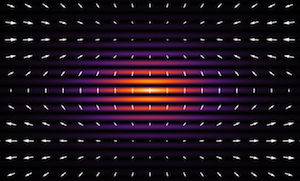Vibrations and Electrons Team Up in New Quantum Entity
Vibrations in a crystal can combine with an electron in a new way to form a hybrid quantum entity, according to a team of theorists publishing in Physical Review Letters. They call it a “phoniton,” a particle that combines a phonon—the quantum form of vibrations—with a matter excitation, such as an electron that transits between two levels. The team also proposes a nanostructure that would support this quantum state and allow it to be observed. Because the new quantum particle represents a coupling of an electron with a localized vibration, the researchers say it could serve in sensors or as a link to quantum computing devices.
Novel quantum states in solids can shed light on basic physics and also lead to ways of improving devices. In a semiconductor, for example, a photon can generate an excited electron and hole (a particle representing the absence of an electron) that quickly annihilate and emit a new photon of the same frequency. By forcing such an event to occur in a reflecting cavity that traps the photon and allows it to continually re-create the electron-hole pair, researchers can create an exciton polariton, a hybrid state of the photon and the electron-hole pair (see 10 February 2000 Focus story).
Charles Tahan and his colleagues at the Laboratory for Physical Sciences and the University of Maryland, both in College Park, wanted to accomplish the same kind of combination, but using atomic vibrations in a material instead of light. From the quantum perspective, waves of vibration passing through a crystal lattice act like particles known as phonons. Although phonons can interact with electrons as they travel through a lattice, inducing a phonon and a matter excitation to form a new hybrid state presents difficulties. In particular, the phonon and the excitation must interact strongly and stay together for a relatively long time.
To create a suitable interaction, Tahan and his colleagues propose using silicon doped with atoms of a “donor” impurity, such as phosphorus. Each donor atom replaces a silicon atom but has an electron to spare, which becomes trapped in a region of the lattice a few nanometers across. If the doped silicon lattice is strained—stretched or squeezed—by the right amount, the ground state and lowest excited state of this extra electron are separated by a few milli-electron-volts (meV) in energy. So a phonon with this energy can excite the electron, boosting it from the ground state to the excited state, and the electron can then emit a similar phonon when it drops back down to the ground state.
The researchers then show theoretically that one way to keep the phonon and the donor electron together for an extended period is with a tiny column of material called a micropillar. The central section of this structure would be a block of phosphorus-doped silicon, perhaps 10nanometers in height, similar to the wavelength of a phonon with the right energy. Growing the silicon on a silicon-germanium base would induce strain in the silicon lattice because of the slight mismatch in the dimensions of the two lattices. The silicon block would be sandwiched between a number of silicon-germanium layers above and below, with different ratios of the two elements, chosen so that the layers reflect phonons.
The micropillar’s central silicon block, with “phonon reflectors” above and below, would act as a resonant cavity that could trap phonons for microseconds, a bit like a microscopic organ pipe tuned to vibrations of a specific frequency. The micropillar’s design is optimized for the interaction of the trapped phonons and donor electrons, to allow the formation of a stable phonon-electron hybrid. Such a device is “readily makeable,” says Tahan, using present-day techniques.
Since it represents a direct coupling of vibrations of a lattice with electrons, Tahan says, the phoniton state could be the basis of mechanical sensors or could translate between phonons and electronic states of a quantum computer. But he expects other uses would emerge once phoniton-supporting devices are built.
The new proposal “is an excellent example of how it may be possible to adapt the ideas used to control photons for use with phonon-based technologies,” says Ryan Beardsley of the University of Nottingham in England. He cautions, though, that “practical realization of these devices is never trivial.”
–David Lindley
David Lindley is a freelance science writer, now retired. His most recent book is The Dream Universe: How Fundamental Physics Lost Its Way (Penguin Random House, 2020).
More Information
Amplifier from Half-Breed Particles (Focus story from 2000)





